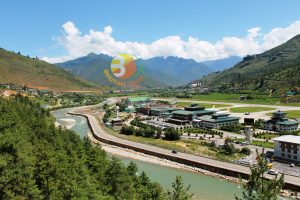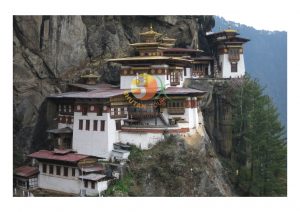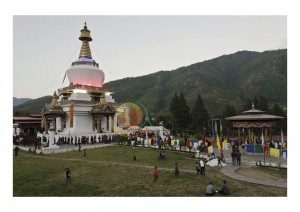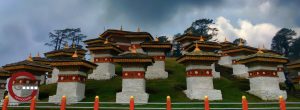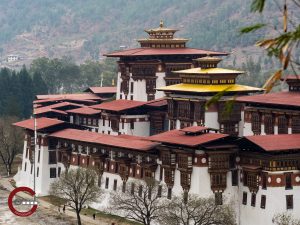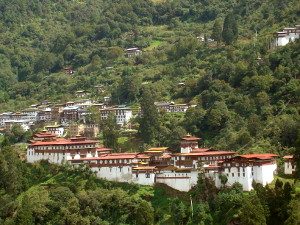Punakha is located in the western part of Bhutan is the winter home of the Je Khenpo, the Chief Abbot of Bhutan. Punakha has been of critical importance since the time of Zhabdrung Ngawang Namgyel in the 17th century.
Zhabdrung Ngawang Namgyal is known as the unifier of Bhutan as a nation state and he was the one who gave Bhutan and its people the distinct cultural identity that identified Bhutan from the rest of the world.
During the 17th century, Bhutan was invaded several times by Tibetan forces seeking to seize a very precious relic, the Ranjung Kharsapani. Zhabdrung Ngawang Namgyal led the Bhutanese to victory over the Tibetans and to commemorate the triumph he introduced the Punakha Drubchen. Since then Punakha Drubchen (also known as Puna Drubchen) became the annual festival of Punakha Dzongkhag.
The Punakha Drubchen is a unique festival because it hosts a dramatic recreation of the scene from the 17th century battle with Tibetan army. The pazap or local militiamen, dress in traditional battle gear and reenact the ancient battle scene. This reenactment harkens back to the time when in the absence of a standing army, men from the eight Tshogchens or great village blocks of Thimphu came forward and managed to expel the invading forces from the country. Their victory ushered in a period of new-found internal peace and stability.
In 2005 another festival known as Punakha Tshechu was introduced by the 70th Je Khenpo Trulku Jigme Choedra and the then Home Minister His Excellency Lyonpo Jigme Yoedzer Thinley. The Tshechu was introduced in response to the requests made by Punakha District Administration and local people to host a Tshechu in order to better preserve Buddhist teachings and keep alive the noble deeds of Zhabdrung Rimpoche.
The best two Punakha Festival Tour not only play an important role in preserving Bhutan’s rich culture and traditions but also provide devout Buddhists with an opportunity for prayer and pilgrimage. They reflect the richness of the Bhutanese cultural heritage and are very special in the eyes and hearts of both Bhutanese and tourists who visit Bhutan.
Tentative Dates:
PUNAKHA DRUBCHEN Punakha Dzong, PUNAKHA 11th – 13th Feb 2019
PUNAKHA TSHECHU Punakha Dzong, PUNAKHA 14th – 17th Feb 2019.
Day 01: Arrive Paro by Druk Air or Bhutan Airlines (L / D) Day 02: Paro (B / L / D) Day 03: Paro / Thimphu (60 km, 2 hours) (B / L / D) Day 04: Thimphu – Punakha (B / L / D) Day 05: Punakha (B / L / D) Day 06: Punakha/ Gangtey (70 km, 3 hours) (B / L / D) Day 07: Gangtey / Trongsa / Bumthang (6 hours) (B / L / D) Day 08: Bumthang (B / L / D) Day 09: Bumthang / Wangduephodrang (205 km, 7 hours) (B / L / D) Day 10: Wangduephodrang / Paro (125 km, 4 hours) (B / L / D) Day 11: Paro Airport Departure (B)
(10 Nights 11 Days)
Paro- Thimphu-Punakha – Gangtey- Trongsa – Bumthnag.
Day 01: Arrive Paro by Druk Air or Bhutan Airlines (L / D)
Druk Airways and Bhutan Airlines flight to Bhutan is one of the most spectacular in the entire Himalayas. Whether flying along the Himalayan range from Kathmandu or over the foothills from Kolkatta, each flight is a mesmerizing aeronautical feat and offers an exciting descent into the Kingdom.
On arrival at Paro airport, immigration and customs formalities and then received by our representative and transfer to the hotel. Evening takes a stroll around town’s main street. Overnight at the hotel in Paro.
Day 02: Paro (B / L / D)
After Breakfast proceeds to Taktsang Palphug Monastery more famous as Paro Taktsang is a Buddhist temple complex which clings to a cliff, 3120 meters above the sea level on the side of the upper Paro valley, Bhutan.
The Taktsang Palphug Monastery is one of the most famous touristic destinations of the country and the cultural icon of Bhutan.
Visiting the Paro Taktsang Monastery is an unforgettable experience thanks to its unique location and the views of surrounding majestic mountains and emerald green valleys.
After lunch drives up the valley to Drukgyel Dzong, built in 1647 by the Shabdrung to commemorate the Bhutanese victory over the Tibetans in the war of 1644.
Visit Ta Dzong (National Museum) and then walk down the trail to visit Rinpung Dzong which has a long and fascinating history.
Overnight at the hotel in Paro.
Day 03: Paro / Thimphu (60 km, 2 hours) (B / L / D)
After breakfast proceeds to Thimphu, the modern capital town of Bhutan. Enroute stop at Chuzom (confluence) where Paro river joins Thimphu river. Afternoon, in Thimphu, visit National Memorial Chorten: The building of this landmark was envisaged by the third king, His Majesty Jigme Dorji Wangchuck, as a monument to world peace and prosperity. Completed in 1974 after his untimely death, it is both a memorial to the Late King (“the Father of modern Bhutan”) and a monument to world peace. The paintings and statues inside the monument provide a deep insight into Buddhist philosophy.
Then proceed to Buddha Dordenma is a gigantic Shakyamuni Buddha statue under construction in the mountains of Bhutan. The statue will house over one hundred thousand smaller Buddha statues, each of which, like the Buddha Dordenma itself, the Buddha Dordenma is sited amidst the ruins of Kuensel Phodrang, the palace of Sherab Wangchuck, the thirteenth Desi Druk, overlooking the southern approach to Thimphu, the capital of Bhutan.
Then, visit Handicrafts Emporium, Textile and Folk Heritage Museum followed by the visit to local market. Trashichhodzong, This impressive fortress/monastery houses Secretariat building, the throne room of His Majesty, the King, and various government offices. It is also the summer residence of Chief Abbot and central monk body also chance to witness the national flag ceremony. Overnight at the hotel in Thimphu.
Day 04: Thimphu – Punakha (B / L / D)
Morning, Thimphu sightseeing, visiting National Library, Painting School, and Traditional Medicine Institute. After lunch, drive to Punakha, the old capital town of Bhutan. Stop en route at Dochula pass (3,050m) that heralds the most enchanting views of Bhutan.
Lunch in Lobesa, afternoon excursion to Chimi Lhakhang, situated on a hillock in the center of the valley, is dedicated to Lama Drukpa Kuenley, who in the late 15th century used humor, songs and outrageous behavior to dramatize his teachings and due to this also known as ‘Divine Madman’. This temple is also known as the temple of fertility. It is widely believed that couples who do not have children and wanting one, if they pray at this temple, they are usually blessed with a child very soon.
On arrival, Punakha check into the hotel.
Day 05: Punakha
Early morning breakfast visits the Punakha and witness the festival during the 17th century Bhutan was invaded several times by Tibetan forces seeking to seize a very precious relic, the Ranjung Kharsapani. Zhabdrung Ngawang Namgyal led the Bhutanese to victory over the Tibetans and to commemorate the triumph he introduced the Punakha Drubchen. Since then Punakha Drubchen (also known as Puna Drubchen) became the annual festival of Punakha Dzongkhag.
Day 06: Punakha/ Gangtey (70 km, 3 hours) (B / L / D)
After breakfast drive to Gangtey via Wangduephodrang. Further ahead pass through dense forests and oak, rhododendron trees, reaching Gangtey (Phobjikha).
The evening takes a walk around Gangtey village and visits Gangtey Gompa, the only Nyingmapa monastery in this region. Overnight at in Gangtey
Day 07: Gangtey / Trongsa / Bumthang (6 hours) (B / L / D)
Morning explore Phobjikha valley which is famous for Black Necked Cranes. The cranes migrate here from Central Asiatic plateau to escape its harsh winters.
After lunch drive to Trongsa crossing 3,300m high Pele la pass. Lunch in Trongsa, afternoon visit to Trongsa Dzong, the masterpiece of Bhutanese architecture and see Ta Dzong, the watchtower, built to defend this Dzong and surrounding region.
After lunch, proceed to Bumthang, the religious heartland of the nation. Evening at leisure. Dinner and overnight at the lodge in Bumthang.
Day 08: Bumthang (B / L / D)
Bumthang is the general name given to the combination of four valleys – Chumey, Choekhor, Tang, and Ura with altitude varying from 2,600m to 4,000m. It is home to many of prominent Buddhist temples and monasteries.
Visit Tamshing Lhakhang, the treasure house of interesting religious Buddhist paintings. Then visit Jakar Dzong, the administrative center of the valley.
Afternoon visit Kurje Lhakhang, one of the most sacred places. Later visit Jambay Lhakhang, the ancient monastery dating from the introduction of Buddhism in the country.
Evening visit to local shops. Overnight at the lodge in Bumthang.
Day 09: Bumthang / Wangduephodrang (205 km, 7 hours) (B / L / D)
The morning after breakfast, drive to Wangdue, Lunch would be served en route at one of the famous restaurant in Trongsa town.
Evening takes a stroll around Wangdue Bajo town, visiting shops, local market and mingling with people. Overnight at the hotel in Wangduephodrang.
Day 10: Wangduephodrang / Paro (125 km, 4 hours) (B / L / D)
After breakfast drive to Paro, reaching in Paro take relaxed in the hotel, do some shopping.
Day 11:
After breakfast transfer to the airport for flight to onward destination.
- Government Royalty: USD 65 per Person per Night.
- 2% Government Tax per Person per Night.
- All Meals.
- Daily Mineral Water.
- English Language Speaking Guide.
- Comfortable and Luxurious Imported Cars for Internal Transportation with Skilled Driver.
- Entrance fees for Museums.
- The Government set package rates are valid for accommodation on twin sharing basis.
- A minimum of 3 star accommodation (4 & 5 star may require an additional premium).
- Airfare international & Domestic.
- Travel Insurance.
- Personal shopping.
- Alcohol.
- Laundry.
- Tips for Guide & Driver.
Book a Tour
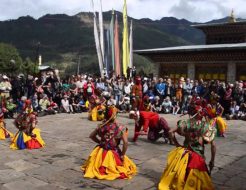
Bhutan Naked Festival 2024
The Jambay Lhakhang, situated in Bumthang and en route to the Kurjie Lhakhang, is the venue for…
Start Date: 15th November 2024
End Date: 18th November 2024
Destination: Jambay Lhakhang, Choekhor, Bumthang
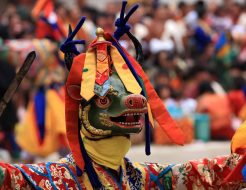
Bhutan Thimphu Festival Tour 2024
One of the biggest festivals in the country is the Thimphu Tshechu. This Thimphu festival tour is…
Start Date: 13th Sept 2024
End Date: 15th Sept 2024
Destination: Tashi Chhodzong, Thimphu
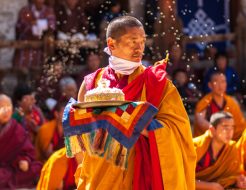
Punakha Festival Tshechu 2024
Punakha, situated in the western part of Bhutan, serves as the winter residence of the Je Khenpo,…
Start Date: 19th - February 2024
End Date: 21st February 2024
Destination: Punakha Dzong
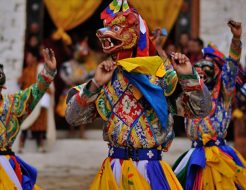
Paro Bhutan Festival 2024
The Paro Festival, an annual event held every spring, stands as one of the most vibrant and…
Start Date: 21st March, 2024
End Date: 25th March, 2024
Destination: Rinpung Dzong, Paro
CONTACT US
- homeThimphu, Bhutan
- emailbookbhutantour@gmail.com
- emailinfo@bhutantouragency.com
- +975-17614054
- +975-02-340662
- +975-17614054
- rdtamang





